#Aitvaras
Explore tagged Tumblr posts
Text


Nahobino had a farm ~
#shin megami tensei v vengeance#smtvv#nahobino#aogami#demon haunt#onmoraki#unicorn#cait sith#neko shogun#zhu tun she#aitvaras#halphas#shin megami tensei#atlus
569 notes
·
View notes
Text

Solomiya is hard of hearing, so she prefers signing when her aids are off. Aiva cannot communicate in a human language when in aitvaras form due to an incompatible voice box, in the story Solomiya teaches them some signs so they could talk to eachother
59 notes
·
View notes
Text

Aitvaras Dude.......... hehe chicken...........
#art#digital art#artwork#my art#furry#furryfandom#digital drawing#postal#postal dude#fandude#fan dude#dudeverse#aitvaras#aitvaras dude#tolys's scribbles
57 notes
·
View notes
Text
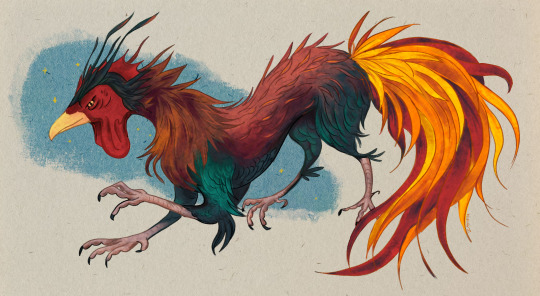

some dragons in Eastern Europe are described to look like roosters or shooting stars and that's just neat
32 notes
·
View notes
Text

Aitvaras likes prepared food such as, notably, scrambled eggs and porridge. It is incredibly difficult to get rid of aitvaras, and while killing it is an option it can heal its injuries by simply touching earthy ground. Additionally, should an aitvaras actually die, its body will leave behind a spark that may easily lead to fire.
#BriefBestiary#bestiary#digital art#fantasy#folklore#legend#myth#mythology#lithuanian folklore#lithuanian legend#aitvaras#atvaras#damavykas#household spirit#dragon#good luck#bad luck
57 notes
·
View notes
Text
Common Damavykas (Galloviperus lithunica) - Undesirable Flaming Rooster of Lithuania



“ Long time when live from the scorch feathers, those feathers are highly flammable when expire into small embers to large-scale wildfire. ”
– Eostre
The Common Damavykas (Galloviperus lithunica), also known by Flaming Damavykas, is the one of the mythical creatures introduced in Historya Davvun, Seven Code Talkers, No Way to Seaway, Weather Dragons, Two Lights, Worldcraft, and Rescris as part of Rapunzel's Tangled Adventure sequels.
Fixes: The Damavykas' appearance and some characteristics, such as the addition of orange edges to the black trosofan, make them resemble Bird Wyvern more than Hypnocatrice or Yian Kut-ku.
Take Note: All of my drawings and photos of people, animals, plants, mythology, disasters, organizations, events, and more are purely fictitious. These are included in real-life situations and events with fictional characters or creatures that aren't real, be at your own risk. For nationality or indigenous, be advised. Ognimdo.
Etymology
Borona is the Sawintiran word in Everrealm which is from Borona, is the Old Tagalog and Old Ilocano word for mysterious large bird, from Malagasy vorona or Malay burung, from Classical Malay بوروڠ (burung), from Malayo-Polynesian *eburuŋ (bird of prey). Damavykas is the Lithuanian word for this species, which is the alternative name of Aitvaras.
Physical Appearance
With its huge torso and white to dark blue green tail feathers on the waist, the Common Damavykas is a Borona (a saurischian wyvern that resembles a rooster, eagle, or pheasant). They look like primitive birds with three fingers and feathers that span in color from red to orange to dandelion to yellow to green. They had a beak-like mouth with serrated teeth and a red head like a rooster. The legs of common Damavykas are three-toed and gray with scales. Beneath these feathers were feather-like, inexplicable, bomb-like organs laced with nitroglycerin. The large, flame-like, yellowish orange feathers on Damavykas' tail acted like actual fire. Damavykas's eyes were hazel in color.
Behavior
Although it is an animal, the Damavykas are thought of as a house spirit because they only use their bomb feathers as an alternative form of defense against intruders and only breathe little fireballs five times. It is same goes to their trusting method as Aitvaras, another species of fowl-like wyvern in Lithuania.
#ognimdo2002#earth responsibly#science fantasy#art#earth#ibispaint art#speculative evolution#art ph#rapunzel's tangled adventure#ibispaintx#bird wyvern#bird world#damavykas#aitvaras#lithuania#lithuanian#mythical
2 notes
·
View notes
Text
Been sick the past couple of days and been playing shin megami tensei V (never played the other titles just saw a friendplaying V and I was like oh wow it's like pokemon but with demons!)
Anyway...my son...my boy whom I cherish with my life 😭❤️
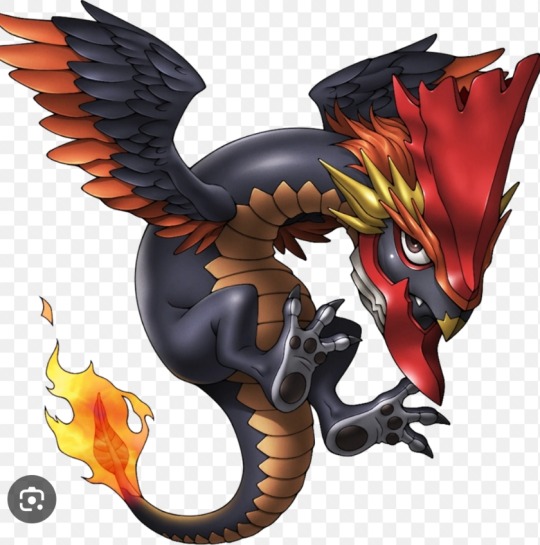
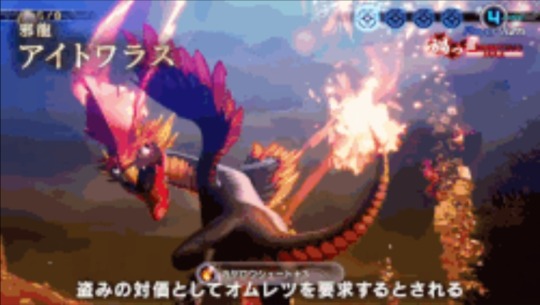
2 notes
·
View notes
Text

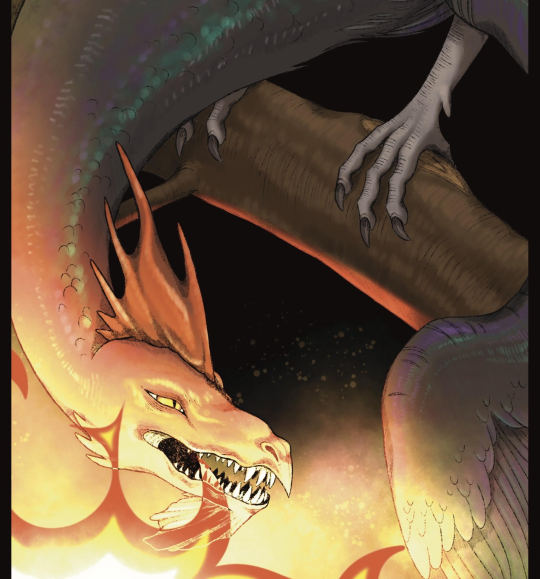

My take on the Aitvaras, one of the creatures from my book (:
0 notes
Text

#smt#shin megami tensei#megaten#smt smpa#smt aitvaras#re: european#shoutout to the wiki listing this guy under 'lituanian mythology'#which just links to the european category anyway
3 notes
·
View notes
Video
youtube
Aitvaras Unknown Creatures from Around the World #shorts ##aitvaras #cre...
#youtube#Aitvaras Unknown Creatures from Around the World shorts aitvaras creatures aroundtheworld Come Find Me At https://linktr.ee/GeekGyrl?utm_
0 notes
Text
Happy Dracones Monday! The Glowtail

Happy Dracones Monday; every monday I show off a dragon from my creative project Dracones Mundi, and today's dragon is the glowtail!
This dragon has a few different varieties, such as the Gandaspati (Javan glowtail), the Aitvaras or Pukis (Baltic glowtail), the Eldkvast (Nordic glowtail) and the Glühschwanz (Western glowtail). The bioluminescence is caused by a bacteria that lives in the tough skin of the dragon's tail - these bacteria are magic sensitive and produce a bioluminescent glow when magic is being used. When the dragon takes flight, using magic, the tail glows. This is a useful way to deter predators who weren't expecting a flash of light during a nighttime hunt.
In Dracones Mundi lore these dragons are closely related to cockatrices. Follow @draconesmundi for a new dragon every Monday!
#Dragons#Wyverns#Dracones Mundi#Dracones Mondays#Glowtail#pondering about renaming this glowwyrm just to have more wyrms...
79 notes
·
View notes
Text
I want to make information on Lithuanian folklore in English more public so I am uploading the threads that until now were only on my Twitter. I present to you a comprehensive thread on aitvarai, the ancient Lithuanian deities of the skies
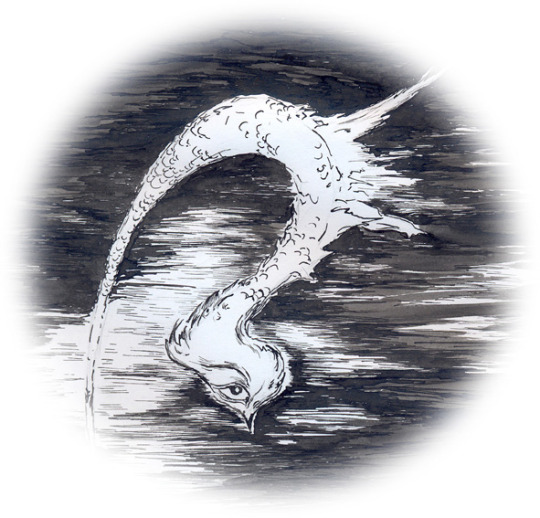
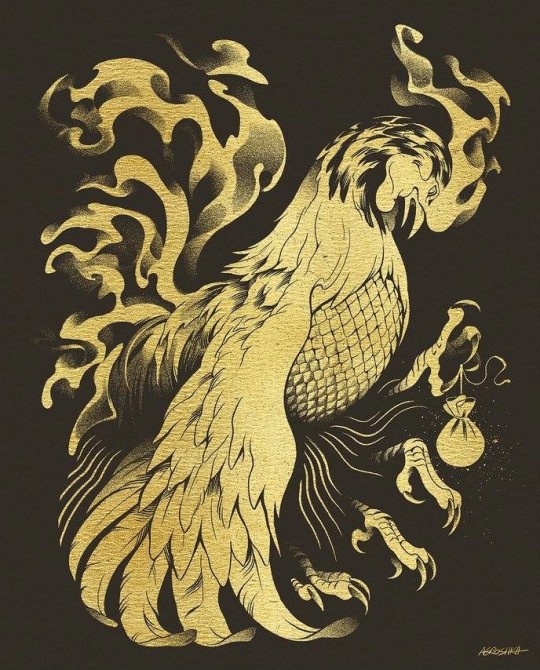
(art credits: Neringa Meškauskaitė, Agroshka )
Aitvarai (etymologically "ones to appease" or "irrepressible force") are domestic creatures associated with all 4 elements: a comet of fire which harnesses wind for chaos, helping Earth and its people while being chased and punished by Perkūnas for stealing water.
Most commonly a black rooster, they can appear as a variety of creatures: different kinds of black birds, grass snakes, whirlwinds, comets and even men if they fall in love with a woman that they want to marry.
Though very powerful ancient beings, Aitvarai choose to associate themselves with people, with villagers being able to either hatch them from an egg of a 7 year old rooster or attract them by leaving out hot, untouched meals like porridge and scrambled eggs.
When part of a household, the duties of an aitvaras were to bring riches to his caretakers, either as money (money carrying aitvarai were golden, deep red or silver in coloration) or as wheat (grey and black colors). Note that aitvarai only served the poor, tricking the wealthy people who tried to use them.
Aitvarai were both a blessing and a curse: while they did bring wealth, they did it by stealing from the neighbors of their master, making them most hated in the local village. They were also clingy and dangerous to keep, burning down the houses of those who mishandled them by feeding them manure, tampering with their meals or disobeying the rules they set for the person.
It is said however that their thieving, evil nature was a characteristic given to them by the Catholic church, which wanted to demonize every pagan creature in Baltic mythology.
In fact, aitvarai were considered genuine problems by those who believed that they would steal from them: from warding off statuettes in granaries to court cases from 1700's accusing people of harboring an aitvaras (I found only one source claiming this, so take it with a grain of salt).
However, the desire to have an aitvaras was apparent as well, shown by modifications peasants would make to their homes: holes in the doors of granaries would be made so an aitvaras could enter the home easily.
Some rituals for stealing back from a flying aitvaras exist as well, ranging from simply showing it your bottom, to cutting oneself with a rusty knife, pinning the corner of your jacket to the ground, ripping or otherwise ruining clothing.
Even if the reaction of people to them was mixed, aitvarai were considered pests by the gods due to their tendency to drink/hoard water, for which they were struck dead by Perkūnas, exploding into sparks that caused forest fires, the thunder god's lightning forming ponds, holes and swamps, terraforming the earth.
#lithuania#mythology#folklore#lithuanian folklore#lithuanian mythology#aitvaras#aitvarai#eastern europe#Viltės threads
176 notes
·
View notes
Text


IM FREE this is the final piece for my tapestry class. I definitely got better at tension as I worked so the edges are kinda wonk and that’s okay. Fun technique would do again. Very loosely inspired by Lithuanian aitvaras aka the chicken dragons.
#artists on tumblr#artwork#tapestry#hand weaving#loom weaving#fiber art#fiber crafts#dragon art#lithuanian mythology
39 notes
·
View notes
Note
Bakugou want to have Minato's Aitvaras cause he's like "I want this f****** chicken".

I'll get to the rest eventually, I'm feelin lazy :v
#persona 3#my hero academia#mha au#boku no hero academia#minato arisato#makoto yuki#bakugou katsuki#my art#vinegar speaks
18 notes
·
View notes
Note
What do you think could be a non elven species that has the fire element
Because for water is obviously fish of all sorts and like mermaids and stuff and for earth its basically any walking animal on land and for air it’s like birds and stuff i assume but what does the fire element have
please tell me you understand what i mean
I have a feeling you probably want to know about races who would primarily use fire magic that aren't elves. But, I'll go through animals/beasts as well. We've seen that any type of animal can have any type of magic, so realistically anything goes.
There are varieties of djinn/"genies" that are commonly associated with fire. A map of Elvendale from season one shows there is a desert region west of Skyra's castle that was never explored, we may have found some djinn here if Elves kept going.

Demons have been mentioned in the series, and we typically associate them with fire. They can be good candidates for a race of fire magic wielders. Oni can also fit into this category, though I'd hesitate to use races covered by other LEGO shows.
In my mind, Dwarfs typically deal in Stone magic, but there are sub-groups who have adapted instead to wield fire.
For animals/beasts that can be closely tied to fire magic:
Dragons are an obvious option that we have gotten in the series, although there are more varieties than just fire.
Phoenix could be another choice as something a little rarer and more mystical. There are other sorts of firebirds from around the world, such as the Basan (Japan), Huma (Iran), or Aitvaras (Lithuania).
Chimeras have been known to breathe fire, but they may be out of place in an Elvendale setting.
Of course there are plenty of fire elementals/spirits to look at depending on your reference culture(s). Same with gods.
Salawa (Arabia) are dog/lion-like beasts covered in flames. Hellhounds run in the same vein, though would probably benefit from a re-naming to fit the world.
While the designers and writer went with Earth as an associated element, Kitsunes are traditionally associated with fire, used to light their way at night. Derived from that, foxes have been paired with fire before.
16 notes
·
View notes
Text
It's the most wonderful list of the year
It is that time of the year again, complete new list time.
COLLECTABLE MONSTERS / ENEMIES
Aatxe • Khalkotauroi Abaia A Bao A Qu Abuhuku Afanc Agropelter Ahool Ahuizotl Airavata Ajaju Akashita Akheilos • Isonade Alicanto Alp-Luachra Amphisbaena ANGEL • Erinyes • Erote • Valkyrie Anggitay Aniwye Ao-Ao • Babi Ngepet • Bonguru • Cuchivilu • Gloson Aproxis Asag Asanbosam Ascalaphus Aswang • Batibat • Berbalang • Kubot • Manananggal • Pugot Awd Goggie
Baku • Bulgasari Baldanders • Frittening • Gardinel Banshee Barghest • Cadejo • Cu Sith • Cwn Annwn • Garmr • Osschaert • Pesanta Barometz • Cactus Cat • Hiiden Hirvi • Otso • Rahara Basilisk Bies BOGEY • Bugbear • Ijiraq • Kaw-Kaw • Kludde • Marabbecca • Metminwi • Nachtkrapp • Stuhac • Tikbalang Boitata Bolotnik • Arzhavennik • Bagiennik • Cueyatl • Yara-Ma-Yha-Who Boobrie Brollachan • Fad Felen • Hongaek Bruch Buggane Bukavac Bunyip • Dingonek Burach Bhadi • Tlanusi Burrunjor • Kasai Rex Bushyasta Butatsch
Caballucos Diablu Cait Sith • Kasha • Nekomata Caladrius • Zhenniao Carbuncle • Arkan Sonney • Cagrino • Yamabiko Catoblepas Charybdis Chupacabra Crocotta • Kishi Cuero • Rumptifusel Cyclops • Bungisngis • Fomorian • Ojancanu • Papinijuwari
Dijiang Dipsa • Haermorrhois • Hypnalis • Seps Dobhar-Chu Domovoi • Leshy • Ovinnik • Polevik • Vodyanoi DRAKE • Aitvaras • Bauk • Jaculus • Qiuniu Dullahan
Echeneis Eintykara ELEMENTAL • Ahi At-Trab • Banaspati • Cherufe • Landvaettir • Nargun • Perico • Raiju • Salamander • Sermilik • Sylph • Undine Encantado • Fossegrim • Katsura-Otoko Eurynomos Ewah
Faun • Huay Chivo Fetch
Ga-Gorib Gargouille Gbahali • Ammut • Cipactli GIANT • Cacus • Gawigawen • Gegenees • Hrimpursar • Muldjewangk Girtablilu Goblin • Akaname • Bilwis • Bugul Noz • Curupira • Dactyl • Eloko • Grindylow • Kobold • Likho • Nuno • Pukwudgie • Redcap • Spriggan • Trenti Gold-Digging Ant GOLEM • Celedon • Invunche • Juggernaut • Pua Tu Tahi • Terra-Cotta • Tupilaq • Wulgaru Griffon • Keythong Grootslang Gu Guarana Gulon • Rompo • Taotie
HAG • Candileja • Hala • Kikimora • Mambabarang • Nocnitsa • Norn • Pesta • Poludnica • Qalupalik • Rokurokubi • Soucouyant • Utlunta • Yanagi-Baba Harpy • Alkonost • Kere • Lechuza • Siren Hippocampus Hrokkall HUMAN • Amazon • Berserker • Buckrider • Cambion • Einherjar • Moroi • Vish Kanya Hyakume Hydra • Ihuaivulu • Nyuvwira
Ichneumon Imp • Butoni • Incubus • Skrzak • Vetala Intulo Inulpamahuida Issitoq • Aghash
Jba Fofi • Djieien • Jorogumo • Tsuchigumo Jinmenju • Jubokko • Umdhlebi Jinn • Ghul • Ifrit • Redjal Marja
Kaiaimunu Kamaitachi Kamikiri Kappa Karkinos • Heikegani • Saratan Kelpie • Apaosha • Ceffyl Dwr • Each Tened • Helhest Keukegen Kilmoulis • Ashinaga • Panotti • Tenaga Kitsune • Kumiho Kodama Kongamato • Ropen Kun Peng Kurage-No-Hinotama • Muirdris
Lamia • Ajatar Lavellan • Rat King • Tesso • Ugjuknarpak Lemure Leprechaun • Amadan Dubh • Clurichaun • Far Darrig • Gancanagh LINNORM • Fafnir • Gowrow • Hodag • Nidhogg Ljosalfar • Dokkalfar Longgui Lou Carcolh Lusca • A-Mi-Kuk • Iku-Turso • Migas • Rogo-Tumu-Here Ly Erg
Makhai Mandarangkal Mandragora Manticore • Nue • Piasa • Sphinx • Succarath • Tarasque Mapinguari Mara Marool Merrow • Adaro • Agloolik • Siyokoy • Yawkyawk • Zitiron Minotaur • Erchitu • Sarangay Mokele-Mbembe • Ninki Nanka Morgawr Moskitto Motelo Mama Muhuru • Mbielu-Mbielu Musca Macedda • Druj Nasu Myrmecoleon
Nadubi • Sigbin Nakshatra Meenu Nalusa Falaya • Hidebehind Namazu Nariphon • Madremonte Ngoubou • Odontotyrannus Nosoi Nuckelavee Nuppeppo NYMPH • Abere • Askafroa • Dryad • Empusa • Lampad • Leanan Sidhe • Maenad • Muse • Nereid • Oread • Rusalka • Thriae • Veela • Yuki-Onna
Olgoi-Khorkhoi • Minhocao • Skolex Olitiau • Guiafairo • Popobawa • Strigoi Omukade • Ankluz • Con Rit • Ek Chapat • Kugdlughiak Oniate • Camacrusa • Chon-Chon • Tsurube-Otoshi Onikuma • Kerit • Skeljaskrimsli
Pard • Ccoa • Mishibizhiw • Mngwa • Splintercat • Zheng Penchapechi Peuchen Phoenix • Psonen • Rarog Piskie • Attercroppe • Lunantishee • Phooka Polong Poltergeist • Dybbuk • Isogashi • Waldgeist Psoglav Pyrausta • Shinchu • Shtriga
Qilin
Ratatoskr Roc Roperite
Salawa Satori Sazae-Oni Scarab • Cerambus • Jinshin Mushi Scitalis Scorpios SEA SERPENT • Gaasyendietha • Haietlik • Ikuchi • Tizheruk Shachihoko Shen Sianach • Delgeth • Wakandagi Skinwalker • Adze • Cuca • Impundulu • Nagual • Rougarou • Selkie Slide-Rock Bolter Sluagh Spartoi • Ahkiyyini • Bloody Bones • Gashadokuro • Mekurabe Squonk Stray Sod • Hungry Grass Stymphalides • Asipatra Surale • Mahaha
Tanuki Teratsutsuki Tiddalik • Chan Chu • Lapiduch Tiyanak • Acheri • Hinkir Munkur • Myling Tripodero TROLL • Aigamuxa • Berberoka • Fear Liath • Kapre • Kayeri • Munuane • Oni • Shellycoat • Yehwe Zogbanu • Yeti Trollgadda Trolual • Bakekujira • Raudkembingur TSUKUMOGAMI • Agrippa • Biwa-Bokuboku • Bubak • Caleuche • Chochin-Obake • Coiste Bodhar • Garei • Hinnagami • Ipetam • Ittan-Momen • Jenglot • Kameosa • Kasa-Obake • Nurikabe • Ungaikyo • Wanyudo • Zorigami Tuyango • Basan
Ulagu UNDEAD ELEMENTAL • Balborinho • Dorotabo • Enenra • Umibozu UNICORN • Almiraj • Karkadann • Shadhawar Utelif
Valravn Velue Vouivre • Asdeev • Caorthannach • Codrille • Cuelebre • Knucker • Snallygaster
Warg • Akhlut • Amarok • Chicheface Water Leaper Wendigo Whowie Will o Wisp • Luz Mala • Ogniki • Santelmo
Xecotcovach Xhumpedzkin
Yale Ya-Te-Veo
Ziphius Zirnitra Zlatorog Zmey • Azi Dahaka Zumbi • Aerico • Baykok • Draugr • Gaki • Hidarugami • Lagahoo • Mokoi • Topielec • Ushabti Zuttibur
UNIQUE MONSTERS/BOSSES
Achlys (General of Pestilence) Adephagia (Sinlord of Gluttony) Aergia (Sinlord of Sloth) Alastor (Sinlord of Wrath) Amhuluk Anansi Anhanga Ankou (General of Death) Antaeus Arachne Argus Aton Baba Yaga Bai Ze Bakunawa Balor Baxbakwalanuxsiwae Belachko Belphegor Byakko Camazotz Cerberus Cetus Chimera Chipfalamfula Deimos & Phobos (Generals of War) Egregore Fenghuang Fulad-Zereh Gaueko Genbu Graeae Gullinbursti Hela Hinqumemen Horseman of Death Horseman of Famine Horseman of Pestilence Horseman of War Hraesvelgr Hundun Itzpapalotl Jack Frost Jack-in-Irons Kampe Khepri Khodumodumo Koschei Kraken Ladon Lilith (Sinlord of Lust) Limos (General of Famine) Lotis Tree Medusa Midas (Sinlord of Greed) Naglfar Narcissus (Sinlord of Pride) Odei Pixiu Planctae Punga Qinglong Quetzalcoatl Qupqugiaq Raktabija Rawhead Saapin Scylla Sin-You Sleipnir Springheel Jack Surtur Tailypo Thunderbird Tiamat Typhon Vritra Wild Hunt Xing Tian Yamata no Orochi Ymir Zelus (Sinlord of Envy)
DELETED/ERASED
Bolla / Inkanyamba / Ouroboros / Shussebora / Tienlung / Suileach / Python / Cirein Croin / Echidna / Snawfus / Porotai / Huldra / Ishigaq / Bluecap / Ramidreju / Capcaun / Barbegazi / Erlkonig / Alraune / Brownie / Changeling / Danthienne / Cernunnos / Nix / Sandman / Tunche / Monoceros / Aziza / Melinoe / Krojemanchen / Jaci Jatere / Hesperid / Davy Jones / Bean Nighe / Tzitzimitl / Ziburinis / Llorona / Morko / Aoandon / Drekavac / Nachzehrer / Strix / Nosferatu / Hannya / Petsuchos / Charon / Shade / Diao Si Gui / Makalala / Jarjacha / Itqiirpak / Gremlin / Colorobetch / Vampire Pumpkin / Binaye Ahani / Tsenahale / Besta-Fera / Pishacha / Humbaba / Abaasy / Beelzebub / Bodach / Pazuzu / Ukobach / Harionago / Kawa Akago / Krampus / Tenome / Tooth Fairy / Ebajalg / Chrysaor / Stolas / Decarabia / Andrealphus / Suiko / Cmuch / Geras / Teke-Teke / Andurá / Cindaku / Teju Jagua / Rangda / Wolpertinger / Muscaliet / Ilomba / Xiao / Qinyuan / Lakuma / Peryton / Otoroshi / Mokumokuren / Mboi Tui / Nguruvilu / Snoligoster / Huallepen / Serpopard / Boggart / Centaur / Gorgon / Globster / Golem / Lorelei / Pegasus / Colossus / Snow Wasset / Dodomeki / Axex / Caliban / Tengu / Dalaketnon / Circe / Moha-Moha / Erymanthian Boar / Erumia / Cerastes / Caspilly / Teumessian Fox / Mamlambo / Drop Bear / Emela Ntouka / Chickcharney / Amphiptere / Atuikakura / Nemean Lion / Fenrir / Veo / Gambo / Tridacna / Anae-Moe-Oho / Scolopendra / Naujakuksualuk / Falajitax / Tculo / Lilyi / Melalo / Mothman / Fachen / Sagari / Geryon / Doppelganger / Hecatoncheires / Marakihau / Taka-Onna / Kigatilik / Cerynitis / Lammasu / Naga / Hrimfaxi / Skinfaxi / Barong / Cocollona / Jormungandr / Kholkikos / Vatnsandi / Nguma-Monene / Bezkost / Karnabo / Apshait / Succubus / Davalpa / Kratt
HALL OF SHAME
Mermaid / Hippogriff / Hupia / Elf / Dwarf / Sasquatch
=====================================
From What Group of Creatures:
DRAGON: Aitvaras / Bauk / Jaculus / Qiuniu / Gargouille / Grootslang / Fafnir / Gowrow / Hodag / Nidhogg / Longgui / Scitalis / Gaasyendietha / Haietlik / Ikuchi / Tizheruk / Shen / Velue / Vouivre / Asdeev / Cuelebre / Knucker / Zirnitra / Zmey / Azi Dahaka / Amhuluk / Bakunawa / Kampe / Ladon / Tiamat / Typhon / Vritra / Yamata no Orochi
FEY: Anggitay / Bonguru / Awd Goggie / Cu Sith / Cwn Annwn / Barometz / Cactus Cat / Hiiden Hirvi / Otso / Bugbear / Ijiraq / Kludde / Nachtkrapp / Tikbalang / Boitata / Bagiennik / Brollachan / Buggane / Cait Sith / Nekomata / Carbuncle / Arkan Sonney / Cagrino / Yamabiko / Ojancanu / Dobhar-Chu / Domovoi / Leshy / Ovinnik / Polevik / Vodyanoi / Raiju / Sylph / Undine / Encantado / Fossegrim / Katsura-Otoko / Faun / Bilwis / Bugul Noz / Curupira / Grindylow / Kobold / Nuno / Pukwudgie / Redcap / Spriggan / Trenti / Pua Tu Tahi / Wulgaru / Guarana / Hala / Kikimora / Mambabarang / Norn / Pesta / Poludnica / Qalupalik / Soucouyant / Utlunta / Yanagi-Baba / Harpy / Lechuza / Siren / Nyuvwira / Inulpamahuida / Jorogumo / Jinmenju / Kamaitachi / Kelpie / Ceffyl Dwr / Kitsune / Kodama / Ropen / Kun Peng / Tesso / Leprechaun / Amadan Dubh / Clurichaun / Far Darrig / Gancanagh / Ly Erg / Mandarangkal / Yawkyawk / Sarangay / Motelo Mama / Nariphon / Nuckelavee / Abere / Dryad / Lampad / Leanan Sidhe / Maenad / Nereid / Oread / Thriae / Veela / Guiafairo / Ankluz / Ccoa / Mishibizhiw / Splintercat / Zheng / Peuchen / Piskie / Attercroppe / Lunantishee / Phooka / Pyrausta / Ratatoskr / Wakandagi / Adze / Stray Sod / Surale / Aigamuxa / Berberoka / Kapre / Kayeri / Munuane / Shellycoat / Yehwe Zogbanu / Yeti / Trollgadda / Almiraj / Karkadann / Shadhawar / Akhlut / Wendigo / Yale / Zuttibur / Anhanga / Baba Yaga / Jack Frost / Lotis Tree / Quetzalcoatl / Springheel Jack / Tailypo / Thunderbird / Wild Hunt
UNDEAD: Aatxe / Khalkotauroi / Gloson / Banshee / Osschaert / Fad Felen / Dullahan / Rompo / Candileja / Hrokkall / Djieien / Jubokko / Ghul / Helhest / Askafroa / Rusalka / Yuki-Onna / Strigoi / Oniate / Camacrusa / Chon-Chon / Tsurube-Otoshi / Mngwa / Penchapechi / Psonen / Polong / Poltergeist / Dybbuk / Isogashi / Waldgeist / Sluagh / Spartoi / Ahkiyyini / Bloody Bones / Gashadokuro / Mekurabe / Hungry Grass / Teratsutsuki / Acheri / Myling / Fear Liath / Bakekujira / Biwa-Bokuboku / Bubak / Caleuche / Chochin-Obake / Coiste Bodhar / Garei / Ittan-Momen / Kameosa / Balborinho / Dorotabo / Enenra / Umibozu / Valravn / Codrille / Will o Wisp / Luz Mala / Ogniki / Santelmo / Zumbi / Aerico / Baykok / Draugr / Gaki / Hidarugami / Lagahoo / Mokoi / Topielec / Ushabti / Ankou / Itzpapalotl / Jack-in-Irons / Koschei / Naglfar / Xing Tian
FIEND: Akashita / Isonade / Erinyes / Aniwye / Babi Ngepet / Aproxis / Asag / Asanbosam / Ascalaphus / Aswang / Batibat / Berbalang / Kubot / Manananggal / Pugot / Garmr / Pesanta / Rahara / Bies / Metminwi / Stuhac / Arzhavennik / Hongaek / Bruch / Kasai Rex / Bushyasta / Caballucos Diablu / Kasha / Catoblepas / Kishi / Fomorian / Cherufe / Nargun / Eurynomos / Huay Chivo / Fetch / Ammut / Cipactli / Gawigawen / Likho / Juggernaut / Taotie / Nocnitsa / Kere / Ihuaivulu / Imp / Butoni / Incubus / Skrzak / Vetala / Aghash / Tsuchigumo / Umdhlebi / Ifrit / Heikegani / Apaosha / Each Tened / Kumiho / Ajatar / Lemure / Rogo-Tumu-Here / Makhai / Nue / Mara / Marool / Siyokoy / Erchitu / Ninki Nanka / Druj Nasu / Sigbin / Nalusa Falaya / Hidebehind / Madremonte / Odontotyrannus / Nosoi / Empusa / Popobawa / Ek Chapat / Onikuma / Rarog / Psoglav / Shtriga / Salawa / Sazae-Oni / Cerambus / Delgeth / Impundulu / Asipatra / Mahaha / Tiyanak / Hinkir Munkur / Oni / Raudkembingur / Agrippa / Ipetam / Jenglot / Wanyudo / Basan / Caorthannach / Chicheface / Xecotcovach / Achlys / Adephagia / Aergia / Alastor / Balor / Belphegor / Camazotz / Cerberus / Deimos & Phobos / Fulad-Zereh / Hela / Hinqumemen / Horseman of Death / Horseman of Famine / Horseman of Pestilence / Horseman of War / Lilith / Limos / Midas / Narcissus / Raktabija / Rawhead / Sin-You / Zelus
MAGICAL: A Bao A Qu / Abuhuku / Afanc / Ahool / Ahuizotl / Alicanto / Amphisbaena / Bulgasari / Basilisk / Bolotnik / Cueyatl / Dingonek / Burach Bhadi / Tlanusi / Zhenniao / Charybdis / Bungisngis / Dipsa / Haermorrhois / Hypnalis / Seps / Echeneis / Eintykara / Ahi At-Trab / Banaspati / Landvaettir / Perico / Salamander / Sermilik / Ga-Gorib / Girtablilu / Dactyl / Gold-Digging Ant / Invunche / Terra-Cotta / Tupilaq / Griffon / Keythong / Gu / Hydra / Jinn / Kappa / Keukegen / Lamia / Ugjuknarpak / Lou Carcolh / A-Mi-Kuk / Iku-Turso / Mandragora / Manticore / Piasa / Sphinx / Succarath / Tarasque / Zitiron / Minotaur / Moskitto / Musca Macedda / Namazu / Minhocao / Kugdlughiak / Satori / Jinshin Mushi / Shachihoko / Rougarou / Squonk / Stymphalides / Kasa-Obake / Ulagu / Amarok / Water Leaper / Xhumpedzkin / Arachne / Belachko / Chimera / Egregore / Gaueko / Graeae / Medusa / Odei / Scylla /
MONSTROSITY: Abaia / Agropelter / Ajaju / Akheilos / Ao-Ao / Barghest / Boobrie / Bunyip / Burrunjor / Chupacabra / Crocotta / Gbahali / Gulon / Hippocampus / Ichneumon / Jba Fofi / Kaiaimunu / Karkinos / Saratan / Kongamato / Lavellan / Lusca / Mapinguari / Mokele-Mbembe / Morgawr / Muhuru / Myrmecoleon / Nadubi / Ngoubou / Olgoi-Khorkhoi / Skolex / Olitiau / Omukade / Con Rit / Skeljaskrimsli / Pard / Roc / Scarab / Scorpios / Sianach / Tiddalik / Trolual / Tuyango / Utelif / Warg / Whowie / Ziphius / Cetus / Kraken / Qupqugiaq /
ABERRATION: Alp-Luachra / Cuchivilu / Baldanders / Frittening / Gardinel / Kaw-Kaw / Marabbecca / Yara-Ma-Yha-Who / Bukavac / Butatsch / Cuero / Rumptifusel / Papinijuwari / Dijiang / Ewah / Akaname / Rokurokubi / Hyakume / Redjal Marja / Kamikiri / Muirdris / Rat King / Migas / Mbielu-Mbielu / Nakshatra Meenu / Nuppeppo / Kerit / Roperite / Slide-Rock Bolter / Lapiduch / Tripodero / Nurikabe / Snallygaster / Ya-Te-Veo / Baxbakwalanuxsiwae / Chipfalamfula / Hundun / Khodumodumo / Planctae / Punga /
HUMANOID: Cyclops / Cacus / Gegenees / Hrimpursar / Muldjewangk / Goblin / Eloko / Amazon / Berserker / Buckrider / Cambion / Einherjar / Moroi / Vish Kanya / Intulo / Kilmoulis / Ashinaga / Panotti / Tenaga / Ljosalfar / Dokkalfar / Merrow / Adaro / Skinwalker / Cuca / Nagual / Selkie / Tanuki / Antaeus / Argus / Hraesvelgr / Saapin / Surtur / Ymir
CELESTIAL: Airavata / Erote / Valkyrie / Baku / Cadejo / Caladrius / Celedon / Alkonost / Issitoq / Kurage-No-Hinotama / Agloolik / Muse / Phoenix / Shinchu / Qilin / Chan Chu / Hinnagami / Ungaikyo / Zorigami / Zlatorog / Anansi / Aton / Bai Ze / Byakko / Fenghuang / Genbu / Gullinbursti / Khepri / Pixiu / Qinglong / Sleipnir
============================
From which Mythology Group.
ANCIENT GREECE: Khalkotauroi / Akheilos / Ascalaphus / Erinyes / Erote / Charybdis / Cyclops / Eurynomos / Faun / Cacus / Gegenees / Dactyl / Celedon / Griffon / Harpy / Kere / Siren / Hippocampus / Amazon / Hydra / Karkinos / Lamia / Lemure / Makhai / Sphinx / Minotaur / Nosoi / Dryad / Empusa / Lampad / Maenad / Muse / Nereid / Oread / Thriae / Cerambus / Scorpios / Spartoi / Stymphalides / Achlys / Adephagia / Aergia / Alastor / Antaeus / Arachne / Argus / Cerberus / Cetus / Chimera / Deimos & Phobos / Graeae / Kampe / Ladon / Limos / Lotis Tree / Medusa / Midas / Narcissus / Planctae / Scylla / Typhon / Zelus
NORTH EUROPEAN: Valkyrie / Gloson / Baldanders / Garmr / Osschaert / Hiiden Hirvi / Otso / Kludde / Nachtkrapp / Landvaettir / Fossegrim / Hrimpursar / Bilwis / Kobold / Gulon / Norn / Pesta / Hrokkall / Berserker / Buckrider / Einherjar / Helhest / Ajatar / Rat King / Fafnir / Nidhogg / Ljosalfar / Dokkalfar / Iku-Turso / Mara / Askafroa / Skeljaskrimsli / Attercroppe / Waldgeist / Ratatoskr / Myling / Trollgadda / Trolual / Raudkembingur / Valravn / Warg / Draugr / Gullinbursti / Hela / Hraesvelgr / Kraken / Naglfar / Sleipnir / Surtur / Ymir
EAST EUROPEAN: Bies / Stuhac / Bolotnik / Arzhavennik / Bagiennik / Bukavac / Domovoi / Leshy / Ovinnik / Polevik / Vodyanoi / Aitvaras / Bauk / Likho / Hala / Kikimora / Nocnitsa / Poludnica / Alkonost / Moroi / Skrzak / Rusalka / Veela / Strigoi / Ankluz / Rarog / Psoglav / Shtriga / Surale / Lapiduch / Hinkir Munkur / Bubak / Ogniki / Zirnitra / Zlatorog / Zmey / Topielec / Zuttibur / Baba Yaga / Belachko / Koschei
SOUTH EUROPEAN: Aatxe / Pesanta / Kaw-Kaw / Marabbecca / Butatsch / Caballucos Diablu / Caladrius / Ojancanu / Perico / Gargouille / Trenti / Butoni / Lou Carcolh / Tarasque / Erchitu / Musca Macedda / Camacrusa / Pyrausta / Agrippa / Balborinho / Velue / Vouivre / Codrille / Cuelebre / Chicheface / Aerico / Ankou / Egregore / Gaueko / Odei
WEST EUROPEAN: Afanc / Alp-Luachra / Awd Goggie / Frittening / Banshee / Barghest / Cu Sith / Cwn Annwn / Bugbear / Boobrie / Brollachan / Fad Felen / Bruch / Buggane / Burach Bhadi / Cait Sith / Arkan Sonny / Fomorian / Dobhar-Chu / Dullahan / Fetch / Bugul Noz / Grindylow / Redcap / Spriggan / Kelpie / Ceffyl Dwr / Each Tened / Kilmoulis / Muirdris / Lavellan / Leprechaun / Amadan Dubh / Clurichaun / Far Darrig / Gancanagh / Ly Erg / Marool / Merrow / Morgawr / Nuckelavee / Leanan Sidhe / Lunantishee / Phooka / Sianach / Selkie / Sluagh / Bloody Bones / Stray Sod / Hungry Grass / Fear Liath / Shellycoat / Coiste Bodhar / Caorthannach / Knucker / Water Leaper / Balor / Jack-in-Irons / Rawhead / Springheel Jack / Wild Hunt
NORTH AMERICAN: Aniwye / Ijiraq / Tlanusi / Sermilik / Ewah / Pukwudgie / Tupilaq / Qalupalik / Utlunta / Issitoq / Djieien / Ugjuknarpak / A-Mi-Kuk / Piasa / Agloolik / Nalusa Falaya / Kugdlughiak / Oniate / Mishibizhiw / Psonen / Gaasyendietha / Haietlik / Tizheruk / Delgeth / Wakandagi / Skinwalker / Rougarou / Ahkiyyini / Mahaha / Ulagu / Akhlut / Amarok / Wendigo / Baykok / Amhuluk / Baxbakwalanuxsiwae / Hinqumemen / Qupqugiaq / Thunderbird
SOUTH/CENTRAL AMERICAN: Abuhuku / Ahuizotl / Alicanto / Ao-Ao / Cuchivilu / Cadejo / Rahara / Metminwi / Boitata / Cueyatl / Carbuncle / Chupacabra / Cuero / Eintykara / Cherufe / Encantado / Huay Chivo / Cipactli / Curupira / Invunche / Guarana / Candileja / Soucouyant / Lechuza / Ihuaivulu / Inulpamahuida / Lusca / Succarath / Mapinguari / Motelo Mama / Madremonte / Minhocao / Ek Chapat / Chon-Chon / Ccoa / Peuchen / Cuca / Nagual / Kayeri / Munuane / Caleuche / Tuyango / Luz Mala / Xecotcovach / Xhumpedzkin / Lagahoo / Anhanga / Camazotz / Itzpapalotl / Quetzalcoatl / Saapin
AFRICAN: Asanbosam / Dingonek / Kasai Rex / Kishi / Ga-Gorib / Gbahali / Eloko / Grootslang / Rompo / Nyuvwira / Intulo / Jba Fofi / Umdhlebi / Kongamato / Migas / Mokele-Mbembe / Ninki Nanka / Muhuru / Mbielu-Mbielu / Ngoubou / Olitiau / Guiafairo / Popobawa / Kerit / Mngwa / Adze / Impundulu / Aigamuxa / Yehwe Zogbanu / Ya-Te-Veo / Zumbi / Anansi / Chipfalamfula / Khodumodumo /
ARABIAN/EGYPTIAN: Asag / Bushyasta / Hypnalis / Ahi At-Trab / Ammut / Girtablilu / Aghash / Jinn / Ghul / Ifrit / Redjal Marja / Saratan / Apaosha / Druj Nasu / Roc / Salawa / Scarab / Almiraj / Karkadann / Shadhawar / Asdeev / Azi Dahaka / Ushabti / Aton / Fulad-Zereh / Khepri / Tiamat
ASIAN: Bulgasari / Hongaek / Zhenniao / Dijiang / Qiuniu / Terra-Cotta / Gu / Taotie / Jinmenju / Kumiho / Kun Peng / Longgui / Nariphon / Olgoi-Khorkhoi / Zheng / Qilin / Shen / Chan Chu / Yeti / Ipetam / Gaki / Bai Ze / Byakko / Fenghuang / Genbu / Hundun / Pixiu / Qinglong / Sin-You / Xing Tian
JAPANESE: Akashita / Isonade / Baku / Kasha / Nekomata / Yamabiko / Raiju / Katsura-Otoko / Akaname / Rokurokubi / Yanagi-Baba / Hyakume / Jorogumo / Tsuchigumo / Jubokko / Kamaitachi / Kamikiri / Kappa / Heikegani / Keukegen / Ashinaga / Tenaga / Kitsune / Kodama / Kurage-no-Hinotama / Tesso / Nue / Namazu / Nuppeppo / Yuki-Onna / Omukade / Tsurube-Otoshi / Onikuma / Isogashi / Shinchu / Satori / Sazae-Oni / Jinshin Mushi / Ikuchi / Shachihoko / Gashadokuro / Mekurabe / Tanuki / Teratsutsuki / Oni / Bakekujira / Biwa-Bokuboku / Chochin-Obake / Garei / Hinnagami / Ittan-Momen / Kameosa / Kasa-Obake / Nurikabe / Ungaikyo / Wanyudo / Zorigami / Basan / Dorotabo / Enenra / Umibozu / Hidarugami / Yamata no Orochi
POLYNESIAN/HINDU: Abaia / A Bao A Qu / Ahool / Airavata / Ajaju / Anggitay / Babi Ngepet / Bonguru / Aswang / Batibat / Berbalang / Kubot / Manananggal / Pugot / Tikbalang / Bungisngis / Banaspati / Gawigawen / Nuno / Juggernaut / Pua Tu Tahi / Mambabarang / Vish Kanya / Vetala / Kaiaimunu / Ropen / Rogo-Tumu-Here / Mandarangkal / Adaro / Siyokoy / Sarangay / Sigbin / Nakshatra Meenu / Abere / Con Rit / Penchapechi / Polong / Asipatra / Tiyanak / Acheri / Berberoka / Kapre / Jenglot / Santelmo / Bakunawa / Raktabija / Vritra
AUSTRALIAN: Yara-Ma-Yha-Who / Bunyip / Burrunjor / Papinijuwari / Nargun / Muldjewangk / Wulgaru / Yawkyawk / Nadubi / Tiddalik / Whowie / Mokoi / Punga
FEARSOME CRITTER: Agropelter / Gardinel / Cactus Cat / Rumptifusel / Gowrow / Hodag / Moskitto / Hidebehind / Splintercat / Roperite / Slide-Rock Bolter / Squonk / Tripodero / Snallygaster / Tailypo
MEDIEVAL BOOK: Amphisbaena / Barometz / Basilisk / Catoblepas / Crocotta / Dipsa / Haermorrhois / Seps / Jaculus / Echeneis / Gold-Digging Ant / Keythong / Ichneumon / Panotti / Manticore / Zitiron / Myrmecoleon / Odontotyrannus / Skolex / Pard / Phoenix / Scitalis / Utelif / Yale / Ziphius
OTHER: Aproxis / Cagrino / Salamander / Sylph / Undine / Goblin / Cambion / Imp / Incubus / Mandragora / Piskie / Poltergeist / Dybbuk / Will o Wisp / Belphegor / Horseman of Death / Horseman of Famine / Horseman of Pestilence / Horseman of War / Jack frost / Lilith
7 notes
·
View notes